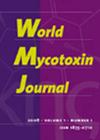Foreword – special issue Mycotoxins in Latin America
IF 1.7
4区 医学
Q3 FOOD SCIENCE & TECHNOLOGY
引用次数: 0
Abstract
Latin America with its considerable North-South extent is subject to climate that varies from tropical, subtropical and warm temperate to temperate. Different agricultural products are produced in the area including cereals, oilseeds, beans, fruits and nuts together with animal production including cattle for beef and milk, pigs, poultry and fish. The heterogeneity of agriculture in Latin America is reflected in the diversity of the region’s farm structures. While agriculture in the Southern Cone is dominated by large, commercial and export-oriented farms, particularly in Argentina and Brazil, besides increasingly in other countries like Uruguay, much of the rest of the region is characterised by smallholder and family agriculture. The contamination of agricultural products with mycotoxins has impact both human and animal health, as well as the economy due to losses related to rejections of agricultural products and by-products during trade. The economic burden related to the consumption of mycotoxins by animals is especially important, causing productivity losses up to the death of animals. The relevant mycotoxins are fumonisins, deoxynivalenol (DON) and zearalenone (ZEN) in cereals and cereal-based products, aflatoxins in cereals, oily seeds and nuts, aflatoxin M1 in milk and dairy products as well as ochratoxin A (OTA) in coffee, grapes and raisins. Co-occurrence of mycotoxins has also been observed mainly with aflatoxins and fumonisins in different Latin American countries (Torres et al., 2015). Advances on legislation in different countries including Argentina, Brazil, Chile, Mexico and Uruguay have been done to establish maximum limits for mycotoxins including aflatoxins, DON, ZEN, OTA, patulin and ergot alkaloids (ANVISA, 2011/2017; CAA, 2019/2021, Norma Oficial Mexicana, N.-243-S., 2010/2010; Reglamento Sanitario de los Alimentos, 2013).前言-拉丁美洲真菌毒素特刊
拉丁美洲具有相当大的南北范围,受热带,亚热带和暖温带到温带气候变化的影响。该地区生产各种农产品,包括谷物、油籽、豆类、水果和坚果,以及生产牛肉和牛奶的牛、猪、家禽和鱼。拉丁美洲农业的异质性反映在该区域农业结构的多样性上。虽然南锥体的农业以大型商业和出口导向型农场为主,特别是在阿根廷和巴西,此外乌拉圭等其他国家也越来越多,但该地区的其他大部分地区都以小农和家庭农业为特征。受真菌毒素污染的农产品不仅影响人类和动物的健康,还会因农产品和副产品在贸易过程中被拒收而造成损失,从而影响经济。与动物食用真菌毒素有关的经济负担尤其重要,造成生产力损失直至动物死亡。相关的真菌毒素是谷物和谷类产品中的伏马毒素、脱氧雪腐镰刀菌醇(DON)和玉米赤霉烯酮(ZEN),谷物、含油种子和坚果中的黄曲霉毒素,牛奶和乳制品中的黄曲霉毒素M1以及咖啡、葡萄和葡萄干中的赭曲霉毒素A (OTA)。在不同的拉丁美洲国家,也观察到真菌毒素主要与黄曲霉毒素和伏马菌素共存(Torres等,2015)。阿根廷、巴西、智利、墨西哥和乌拉圭等不同国家在制定霉菌毒素(包括黄曲霉毒素、DON、ZEN、OTA、棒曲霉素和麦角生物碱)的最高限量方面取得了立法进展(ANVISA, 2011/2017;CAA, 2019/2021, Norma official Mexicana, n -243- s。, 2010/2010;《食品卫生条例》,2013)。
本文章由计算机程序翻译,如有差异,请以英文原文为准。
求助全文
约1分钟内获得全文
求助全文
来源期刊

World Mycotoxin Journal
MYCOLOGY-
CiteScore
4.60
自引率
5.00%
发文量
25
审稿时长
>12 weeks
期刊介绍:
''World Mycotoxin Journal'' is a peer-reviewed scientific journal with only one specific area of focus: the promotion of the science of mycotoxins. The journal contains original research papers and critical reviews in all areas dealing with mycotoxins, together with opinions, a calendar of forthcoming mycotoxin-related events and book reviews. The journal takes a multidisciplinary approach, and it focuses on a broad spectrum of issues, including toxicology, risk assessment, worldwide occurrence, modelling and prediction of toxin formation, genomics, molecular biology for control of mycotoxigenic fungi, pre-and post-harvest prevention and control, sampling, analytical methodology and quality assurance, food technology, economics and regulatory issues. ''World Mycotoxin Journal'' is intended to serve the needs of researchers and professionals from the scientific community and industry, as well as of policy makers and regulators.
 求助内容:
求助内容: 应助结果提醒方式:
应助结果提醒方式:


